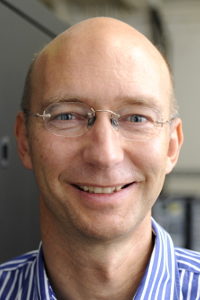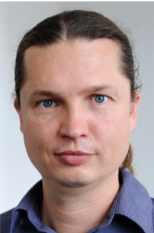Theoretical Chemistry
Overview
People
Görling group
Methods and Software
Research Projects
Novel density-functional methods based on the adiabatic-connection fluctuation-dissipation (ACFD) theorem
Exact-exchange methods for taking into account spin-orbit interactions and the electronic temperature in semiconductors and topological insulators
Carbon-rich materials
Catalysis at liquid interfaces
Chemical storage of solar energy
Liquid organic hydrogen carriers (LOHCs)
Selected Publications
Novel DFT methods based on the ACFD theorem
- A. Görling, Hierarchies of methods towards the exact Kohn-Sham correlation energy based on the adiabatic-connection fluctuation-dissipation theorem, Phys. Rev. B 99, 235120 (2019).
- A. Thierbach, D. Schmidtel and A. Görling, Robust and Accurate Hybrid Random-Phase-Approximation Methods, J. Chem. Phys.151, 144117 (2019).
- J. Erhard, P. Bleiziffer and A. Görling, Power series approximation for the correlation kernel leading to Kohn-Sham methods combining accuracy, computational efficiency, and general applicability, Phys. Rev. Lett. 117, 143002 (2016).
- P. Bleiziffer, A. Heßelmann and A. Görling, Resolution of identity approach for the Kohn-Sham correlation energy within the exact-exchange random-phase approximation, J. Chem. Phys.136, 134102 (2012).
- A. Heßelmann and A. Görling, Correct Description of the Bond Dissociation Limit without Breaking Spin Symmetry by a Random-Phase-Approximation Correlation Functional, Phys. Rev. Lett. 106, 093001 (2011).
Exact-exchange methods for taking into account spin-orbit interactions and the electronic temperature in semiconductors and topological insulators
- E. Trushin, L. Fromm and A. Görling, Assessment of the exact-exchange-only Kohn-Sham method for the calculation of band structures for transition metal oxide and metal halide perovskites, Phys. Rev. B 100, 075205 (2019).
- E. Trushin and A. Görling, Topological phase transitions in zinc-blende semimetals driven exclusively by electronic temperature, Phys. Rev. Lett. 120, 146401 (2018).
Carbon-rich materials
- P. Vecera, J. C. Chacón-Torres, T. Pichler, S. Reich, H. R. Soni, A. Görling, K. Edelthalhammer, H. Peterlik, F. Hauke
und A. Hirsch, Precise determination of graphene functionalization by in situ Raman spectroscopy, Nat. Commun. 8, 15192 (2017). - C. Steiner, J. Gebhardt, M. Ammon, Z. Yang, A. Heidenreich, N. Hammer, A. Görling, M. Kivala und S. Maier, Hierarchical on-surface synthesis and electronic structure of carbonyl-functionalized one- and two-dimensional covalent nanoarchitectures, Nat. Commun. 8, 14765 (2017).
- D. Malko, F. Viñes, C. Neiss und A. Görling, Competition for graphene: graphynes with directional-dependent Dirac cones, Phys. Rev. Lett. 108, 086804 (2012).
Catalysis at liquid interfaces
- T. Bauer, S. Maisel, D. Blaumeiser, J. Vecchietti, N. Taccardi, P. Wasserscheid, A. Bonivardi, A. Görling und J. Libuda, Operando DRIFTS and DFT study of propane dehydrogenation over solid and liquid supported xPty Catalysts, ACS Cat. 9, 2842-2853 (2019).
- N. Taccardi, M. Grabau, J. Debuschewitz, M. Distaso, M. Brandl, R. Hock, F. Maier, C. Papp, J. Erhard, C. Neiss, W. Peukert, A. Görling, H.-P. Steinrück, P. Wasserscheid Gallium-rich Pd-Ga phases as supported liquid metal catalysts, Nat. Chem. 9, 862-867 (2017).
Chemical storage of solar energy
- C. Schuschke, C. Hohner, M. Jevric, A. U. Petersen, Z. Wang, M. Schwarz, M. Kettner, F. Waidhas, L. Fromm, C. Sumby, A. Görling, O. Brummel, K. Moth-Poulsen, J. Libuda, Solar energy storage at an atomically defined organic-oxide hybrid interface, Nat. Comm. 10, 2384 (2019).
- F. Waidhas, M. Jevric, L. Fromm, M. Bertram, A. Görling, K. Moth-Poulsen, O. Brummel, J. Libuda, Electrochemically Controlled Energy Storage in a Norbornadiene-Based Solar Fuel with 99% Reversibility Nano Energy, 63, UNSP 103872 (2019).
Liquid organic hydrogen carriers (LOHCs)
- P. Bachmann, J. Steinhauser, F. Späth, F. Düll, U. Bauer, R. Eschenbacher, F. Hemauer, M. Scheuermeyer, A. Bösmann, M. Büttner, C. Neiss, A. Görling, P. Wasserscheid, H.-P. Steinrück und C. Papp, Dehydrogenation of the Liquid Organic Hydrogen Carrier System 2-methylindole/2-methylindoline/2-methyloctahydroindole on Pt(111), J. Chem. Phys. 151, 144711 (2019).
Zahn Group
Methods and Software
The group uses static electronic structure methods (density-functional theory, wave-function-based methods), classical (empirical interaction models) molecular dynamics simulations, quantum/classical approaches and molecular modelling packages.
Used software packages are:
- LAMMPS
- GULP
- Gaussian
- Quantum Espresso
- Materials Studio
For QM/MM modelling we typically use LAMMPS scripts interfacing with dedicated QM calculations.
Research Projects
Reactions in complex Systems
We explore the mechanisms of reactions in condensed phases from quantum/ classical and ab-initio molecular dynamics simulations. A special focus is dedicated to proton transfer reactions occurring during crystal aggregation and ripening.
Self-Organization of Crystals, Macro-molecules and Composites
Starting from the association of single ions our simulations allow the investigation of the infancy of crystal nucleation from solution. This provides a unique level of insights into (self)-organization and its interplay with ripening reactions and interactions to growth-controlling molecules. The latter aspect allows also the investigation of hybrid materials.
Phase Transitions and Phase Separation
Our studies of phase transitions involve solid-solid, liquid-solid and liquid-vapor transformations. The main focus is dedicated to the mechanisms of phase nucleation and growth. In multinary systems also the interplay of phase transformation with segregation phenomena is explored (distillation, crystallization of eutectic systems).
Materials Simulations
Atomistic and coarse-grained models are used to explore the structure and mechanical properties of nano-crystals and bulk materials. These studies include atomic mobility, defect arrangements, dislocations, grain and phase boundaries as well as their role during deformation and fracture.
Sampling Bio-molecular Systems
The immense complexity of bio-molecular processes calls for advanced molecular dynamics protocols to assess the mechanisms and structures involved. We develop new simulation techniques to study biomolecule solvation, folding and docking to ligands without imposing restraints on protein flexibility or the arrangement of the solvent.
Method Development
The investigation of rare barrier crossing events (reactions, nucleation processes) requires efficient simulation strategies. To tackle the time/length scale problem we apply transition path sampling, constraint MD simulations and related approaches. Diffusion controlled processes, like crystal aggregation from dilute solutions impose different challenges to computer simulation. For this purpose, we develop specific approaches which allow to study aggregation and growth at the atomistic level of detail.
Force-Field Development
To enable molecular mechanics or efficient QM/MM modelling at high accuracy we develop tailor-made force-fields to extend the scope of off-the-shelf models where needed. Examples are molecular mechanics models of the different states of photo-switches and molecules before/after (de)protonation reactions. Moreover, for the prospering field of modelling additives in oil and at oil-steel interfaces, our OilF force-field is continuously extended to enable the molecular simulation of anti-wear films, debris dispersion and tribology at the nm scale.
Selected Publications
Reactions in complex Systems
- P. Becker, T. Wonglakhon, D. Zahn, D. Gudat, R. Niewa, Approaching Dissolved Species in Ammonoacidic GaN Crystal Growth: A Combined Solution NMR and Computational Study, Chem.Eur.J., in press.
- H.P. Huinink, S. Sansotta, D. Zahn, Defect-driven water migration in MgCl2 tetra- and hexahydrates, J. Solid State Chem., 277, 221-228. (2019)
Self-Organization of Crystals, Macro-molecules and Composites
- M.Burraschi, S.Sansotta, D.Zahn, Polarization Effects in Dynamic Interfaces of Platinum Electrodes and Ionic Liquid Phases: a Molecular Dynamics Study, J. Phys. Chem. C., 124, 3, 2002-2007. (2020)
- P.Duchstein, P.Ectors and D.Zahn, Molecular simulations of crystal growth: From understanding to tailoring, Advances in Inorganic Chemistry, 73, 507-529. https://doi.org/10.1016/bs.adioch.2018.11.004 (2019)
Phase Transitions and Phase Separation
- H.Park, A.May, L.Portilla, H.Dietrich, F.Münch, T.Rejek, M.Sarcletti, L.Banspach, D.Zahn and M.Halik, Simple and efficient magnetic removal of glyphosate from water, Nature Sustainability, in press. https://doi:10.1038/s41893-019-0452-6
- M.Sarcletti, H.Dietrich, T.Luchs, D.Vivod, T.Rejek, L.Portilla, D.Zahn, A.Hirsch and M.Halik, Superoleophilic magnetic iron oxide nanoparticles for effective hydrocarbon removal from water, Adv. Funct. Mater. , 29, 1805742. https://doi.org/10.1002/adfm.201805742 (2019)
Materials Simulations
- B.Becit, P.Duchstein, D.Zahn, Molecular mechanisms of mesoporous silica formation from colloid solution: ripening-reactions arrest hollow network structures, PLOS One, 14, e0212731. (2019)
- J.Wittmann, C.Henkel, J.Träg, J.Will, L.Stiegler, P.Strohriegl, A.Hirsch, T.Unruh, D.Zahn, D.M. Guldi, M.Halik, Mixed Organic Ligand Shells: Controlling the Nanoparticle Surface Morphology towards Tuning the Optoelectronic Properties, Small, 16, 1903729. (2020)
Sampling Biomolecular Systems
- C.Debus, B.Wu, T.Kollmann, P.Duchstein, M.Siglreitmeier, S.Herrera, D.Benke,D.Kisailus, D.Schwahn, V.Pipich, D.Faivre, D.Zahn, H.Cölfen, Bio-inspired Multifunctional Layered Magnetic Hybrid Materials, Bioinspired Biomimetic and Nanobiomaterials, 8, 1-66. (2019)
- J.Träg, P.Duchstein, M.Hennemann, T.Clark, D.M.Guldi, D.Zahn, Size-Dependent Local Ordering in Melanin Aggregates and its Implication on Optical Properties, J.Phys.Chem.A, 123, 9403-9412 (2019)
Method Development
- D.Zahn, On the solvation of metal ions in liquid ammonia: a molecular simulation study of M(NH2)x(NH3)y complexes as functions of pH, RSC Advances, 7, 54063-54067. (2017)
- J.Anwar, D.Zahn, Polymorphic Phase Transitions: Macroscopic Theory and Molecular Simulation, Advanced Drug Delivery Reviews, 117, 47-70. (2017)
Force-Field Development
- T.Wonglakhon, D.Zahn, Interaction Potentials for modelling GaN precipitation and solid state polymorphism, J.Phys.:Cond.Mat. in press.
- P.Ectors, D.Zahn, Benchmarking and optimization of molecular simulation models of zinc dialkyldithio-phosphate and calcium sulfonate oil additives, J.Mol.Model., 25, 100. (2019)

